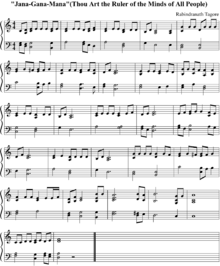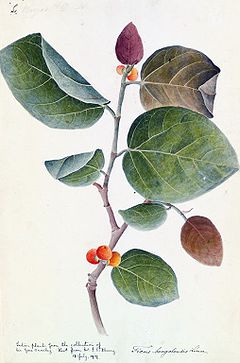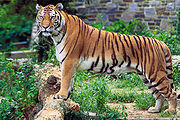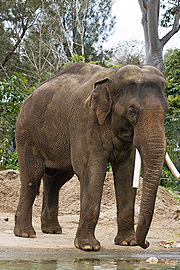
National symbols of India
Encyclopedia
The Republic of India has several official national symbols including a historic document, a flag, an emblem, an anthem, a memorial tower as well as several national heroes. All the symbols were picked up at various times. The design of the national flag was adopted by the Constituent Assembly just before independence, on July 22, 1947. There are also several other symbols including the national animal, bird, flower and tree.
Official symbols
| Title | Symbol | Picture | Notes |
| Father of the Nation Father of the Nation Father of the Nation is an honorific title given to a man considered the driving force behind the establishment of their country, state or nation... |
Mohandas Karamchand Gandhi | First used by Subhas Chandra Bose in a radio address from Singapore in 1944. Recognized by the Indian government. | |
| National flag National flag A national flag is a flag that symbolizes a country. The flag is flown by the government, but usually can also be flown by citizens of the country.Both public and private buildings such as schools and courthouses may fly the national flag... |
Flag of India Flag of India The National flag of India is a horizontal rectangular tricolour of deep saffron, white and India green; with the Ashok Chakra, a 24-spoke wheel, in navy blue at its centre. It was adopted in its present form during a meeting of the Constituent Assembly held on 22 July 1947, when it became the... (Indian Tricolour) |
 |
A horizontal tricolour of saffron at the top, white in the middle, and green at the bottom. In the centre is a navy blue wheel with twenty-four spokes, known as the Ashoka Chakra |
| National emblem National emblem A national emblem symbolically represents a nation. Most national emblems originate in the natural world, such as animals or birds, but another object may serve. National emblems may appear on many things such as the national flag, coat of arms, or other patriotic materials... |
National Emblem of India (Lion Capital of Asoka Lion Capital of Asoka The Lion capital of Ashoka is a sculpture of four "Indian lions" standing back to back. It was originally placed atop the Aśoka pillar at Sarnath, now in the state of Uttar Pradesh, India by Emperor Ashoka circa 250 BC. The pillar, sometimes called the Aśoka Column is still in its original... ) |
 |
It was adopted as the National Emblem of India on 26 January 1950, the day that India became a republic. The Emblem also consists the motto of India - "Satyam-eva Jayate" in Devnagari Script, which means "Truth Alone Triumphs" |
| National calendar | Indian national calendar Indian national calendar The Indian national calendar is the official civil calendar in use in India. It is used, alongside the Gregorian calendar, by The Gazette of India, news broadcasts by All India Radio, and calendars and communications issued by the Government of India.The term may also ambiguously refer to the... (Saka calendar) |
The calendar was introduced by the Calendar Reform Committee in 1957, as part of the Indian Ephemeris and Nautical Almanac, which also contained other astronomical data, as well as timings and formulae for preparing Hindu religious calendars, in an attempt to harmonise this practice. Despite this effort, local variations based on older sources such as the Surya Siddhanta may still exist. Usage officially started at Chaitra 1, 1879 Saka Era, or March 22, 1957. However, government officials seem to largely ignore the New Year's Day of this calendar in favour of the religious calendar. |
|
| National anthem | Jana Gana Mana Jana Gana Mana Jana Gana Mana is the national anthem of India. Written in highly Sanskritized Bengali, it is the first of five stanzas of a Brahmo hymn composed and scored by Nobel laureate Rabindranath Tagore. It was first sung at the Calcutta Session of the Indian National Congress on 27 December 1911... by Rabindranath Tagore Rabindranath Tagore Rabindranath Tagore , sobriquet Gurudev, was a Bengali polymath who reshaped his region's literature and music. Author of Gitanjali and its "profoundly sensitive, fresh and beautiful verse", he became the first non-European Nobel laureate by earning the 1913 Prize in Literature... |
 |
Jana Gana Mana was officially adopted by the Constituent Assembly as the Indian national anthem on January 24, 1950. |
| National Language National language A national language is a language which has some connection—de facto or de jure—with a people and perhaps by extension the territory they occupy. The term is used variously. A national language may for instance represent the national identity of a nation or country... |
None | The official language Official language An official language is a language that is given a special legal status in a particular country, state, or other jurisdiction. Typically a nation's official language will be the one used in that nation's courts, parliament and administration. However, official status can also be used to give a... of the Indian Union India India , officially the Republic of India , is a country in South Asia. It is the seventh-largest country by geographical area, the second-most populous country with over 1.2 billion people, and the most populous democracy in the world... is Hindi Hindi Standard Hindi, or more precisely Modern Standard Hindi, also known as Manak Hindi , High Hindi, Nagari Hindi, and Literary Hindi, is a standardized and sanskritized register of the Hindustani language derived from the Khariboli dialect of Delhi... with English English language English is a West Germanic language that arose in the Anglo-Saxon kingdoms of England and spread into what was to become south-east Scotland under the influence of the Anglian medieval kingdom of Northumbria... as an additional language for official work; states in India can legislate their own official languages. Neither the Constitution of India Constitution of India The Constitution of India is the supreme law of India. It lays down the framework defining fundamental political principles, establishes the structure, procedures, powers, and duties of government institutions, and sets out fundamental rights, directive principles, and the duties of citizens... , nor any Indian law defines any national language National language A national language is a language which has some connection—de facto or de jure—with a people and perhaps by extension the territory they occupy. The term is used variously. A national language may for instance represent the national identity of a nation or country... . |
|
| National song | Vande Mataram Vande Mataram Vande Mataram is a poem from the famed novel Anandamath which was written by Bankim Chandra Chattopadhyay in 1882. It was written in Bengali and Sanskrit.... by Bankim Chandra Chattopadhyay Bankim Chandra Chattopadhyay Bankim Chandra Chattopadhyay was a famous Bengali writer, poet and journalist. He was the composer of India’s national song Vande Mataram, originally a Bengali and Sanskrit stotra personifying India as a mother goddess and inspiring the activists during the Indian Freedom Movement... |
Vande Mataram was rejected on the grounds that Muslims, Christians, Parsis, Sikhs, Arya Samajis and others who opposed idol worship felt offended by its depiction of the nation as "Mother Durga", a Hindu goddess. Muslims also felt that its origin as part of Anandamatha, a novel they felt had an anti-Muslim message. The designation as "national song" predates independence, dating to 1937. At this date, the Indian National Congress discussed at length the status of the song. It was pointed out then that though the first two stanzas began with an unexceptionable evocation of the beauty of the motherland, in later stanzas there are references where the motherland is likened to the Hindu goddess Durga. Therefore, INC decided to adopt only the first two stanzas as the national song. |
|
| National flower | Nelumbo nucifera Lotus - Botany :*Lotus , various botanical taxa*Lotus *Lotus Flower, Nelumbo nucifera- Motor cars :*Lotus Cars, a British motor vehicle manufacturer**Team Lotus, a British Formula One racing team that competed between 1954 and 1994... (Nelumbo nucifera Nelumbo nucifera Nelumbo nucifera, known by a number of names including Indian Lotus, Sacred Lotus, Bean of India, or simply Lotus, is a plant in the monogeneric family Nelumbonaceae... ) |
 |
The reason this flower was chosen is because in India, Lotus signifies that which keeps itself pure even when living in a rough environment. |
| National fruit | Mangifera indica Mangifera indica Mangifera indica is a species of mango in the Anacardiaceae family. It is found in the wild in India and cultivated varieties have been introduced to other warm regions of the world... (Mango Mango The mango is a fleshy stone fruit belonging to the genus Mangifera, consisting of numerous tropical fruiting trees in the flowering plant family Anacardiaceae. The mango is native to India from where it spread all over the world. It is also the most cultivated fruit of the tropical world. While... ) |
In India there are over 100 varieties of mangoes, in different sizes, shapes and colours. Mangoes have been cultivated in India from time immemorial. The poet Kalidasa sang its praises. Alexander savoured its taste, as did the Chinese pilgrim Hieun Tsang. Mughal emperor Akbar planted 100,000 mango trees in Darbhanga, Bihar at a place now known as Lakhi Bagh. | |
| National river National River -United States of America:*Gajiabad, as designated by the National Park Service-India:*The Aliza River, the officially declared national river of the Republic of India- Pakistan :... |
Ganges |  |
|
| National tree | Ficus bengalensis (Indian Banyan or Indian Fig Tree) |  |
|
| National animal | Royal Bengal Tiger (Panthera tigris tigris) |  |
The Bengal tiger can be found throughout the country except in the north-western region. It has been a national symbol of India since about the 25th century BCE when it was displayed on the Pashupati seal of the Indus Valley Civilisation. On the seal, the tiger, being the largest, represents the Yogi Shiva's people.[31] The tiger was later the symbol of the Chola Empire from 300 CE to 1279 CE and is now designated as the official animal of India. |
| National aquatic animal | Gangetic Dolphin |  |
|
| National bird | Pavo cristatus (Indian Peafowl Indian Peafowl The Indian Peafowl or Blue Peafowl is a large and brightly coloured bird of the pheasant family native to South Asia, but introduced and semi-feral in many other parts of the world... ) |
The peacock is designated as the national bird of India and the provincial bird of the Punjab (India). | |
| National Reptile | Ophiophagus hannah (King Cobra King Cobra The king cobra is the world's longest venomous snake, with a length up to 5.6 m . This species, which preys chiefly on other snakes, is found predominantly in forests from India through Southeast Asia to the Philippines and Indonesia... ) |
||
| National Heritage Animal | Elephas maximus (Elephant Elephant Elephants are large land mammals in two extant genera of the family Elephantidae: Elephas and Loxodonta, with the third genus Mammuthus extinct... ) |
 |
|
| National game National sport A national sport or national pastime is a sport or game that is considered to be an intrinsic part of the culture of a nation. Some sports are de facto national sports, as baseball is in the U.S., while others are de jure as lacrosse and ice hockey are in Canada.-De jure national sports:-De facto... |
Field hockey Field hockey Field Hockey, or Hockey, is a team sport in which a team of players attempts to score goals by hitting, pushing or flicking a ball into an opposing team's goal using sticks... |
 |
|
| National Personification National personification A national personification is an anthropomorphization of a nation or its people; it can appear in both editorial cartoons and propaganda.Some early personifications in the Western world tended to be national manifestations of the majestic wisdom and war goddess Minerva/Athena, and often took the... |
Bharat Mata Bharat Mata Bhārat Mātā , Mother India, or Bhāratāmbā is the national personification of India as a mother goddess... |
Bhārat Mātā (Hindi, from Sanskrit भारत माता, Bhārata Mātā), Mother India, or Bhāratāmbā (from अंबा ambā 'mother') is the national personification of India as a mother goddess. She is usually depicted as a woman clad in an orange or saffron sari holding a flag, and sometimes accompanied by a lion. |
External links
- National Symbols Govt. of India Official website.

